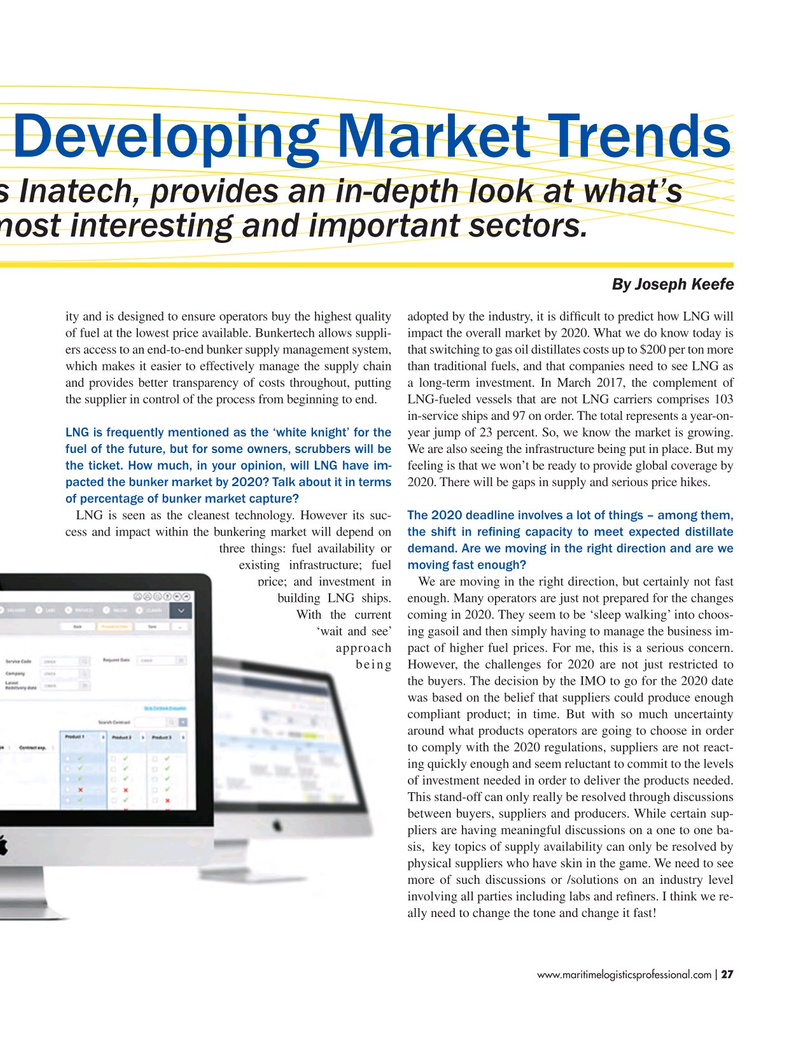
Page 27: of Maritime Logistics Professional Magazine (Jul/Aug 2017)
PORTS & INFRASTRUCTURE
Read this page in Pdf, Flash or Html5 edition of Jul/Aug 2017 Maritime Logistics Professional Magazine
Global Bunkers, 2020 and Developing Market Trends
Alok Sharma, Head of Global Sales at Glencore’s Inatech, provides an in-depth look at what’s coming next for one of the maritime industry’s most interesting and important sectors.
By Joseph Keefe ity and is designed to ensure operators buy the highest quality adopted by the industry, it is diffcult to predict how LNG will of fuel at the lowest price available. Bunkertech allows suppli- impact the overall market by 2020. What we do know today is ers access to an end-to-end bunker supply management system, that switching to gas oil distillates costs up to $200 per ton more which makes it easier to effectively manage the supply chain than traditional fuels, and that companies need to see LNG as and provides better transparency of costs throughout, putting a long-term investment. In March 2017, the complement of the supplier in control of the process from beginning to end. LNG-fueled vessels that are not LNG carriers comprises 103 in-service ships and 97 on order. The total represents a year-on-
LNG is frequently mentioned as the ‘white knight’ for the year jump of 23 percent. So, we know the market is growing. fuel of the future, but for some owners, scrubbers will be We are also seeing the infrastructure being put in place. But my the ticket. How much, in your opinion, will LNG have im- feeling is that we won’t be ready to provide global coverage by pacted the bunker market by 2020? Talk about it in terms 2020. There will be gaps in supply and serious price hikes.
of percentage of bunker market capture?
LNG is seen as the cleanest technology. However its suc- The 2020 deadline involves a lot of things – among them, cess and impact within the bunkering market will depend on the shift in refning capacity to meet expected distillate three things: fuel availability or demand. Are we moving in the right direction and are we existing infrastructure; fuel moving fast enough?
price; and investment in We are moving in the right direction, but certainly not fast building LNG ships. enough. Many operators are just not prepared for the changes
With the current coming in 2020. They seem to be ‘sleep walking’ into choos- ‘wait and see’ ing gasoil and then simply having to manage the business im- approach pact of higher fuel prices. For me, this is a serious concern. being However, the challenges for 2020 are not just restricted to the buyers. The decision by the IMO to go for the 2020 date was based on the belief that suppliers could produce enough compliant product; in time. But with so much uncertainty around what products operators are going to choose in order to comply with the 2020 regulations, suppliers are not react- ing quickly enough and seem reluctant to commit to the levels of investment needed in order to deliver the products needed.
This stand-off can only really be resolved through discussions between buyers, suppliers and producers. While certain sup- pliers are having meaningful discussions on a one to one ba- sis, key topics of supply availability can only be resolved by physical suppliers who have skin in the game. We need to see more of such discussions or /solutions on an industry level involving all parties including labs and refners. I think we re- ally need to change the tone and change it fast!
www.maritimelogisticsprofessional.com 27
I

 26
26

 28
28
